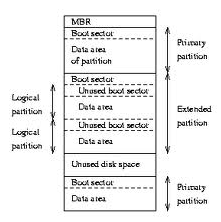Data Recovery -> Dynamic disk
Storage devices
Types of HDD
Partition Series
Linux
Operating Systems
Windows
Dynamic disk
 Windows 2000 introduces the concept of basic disk and dynamic disk and puts them into the tools of Windows system administrator. The biggest difference between them is the support from operating systems. All windows editions even DOS are in support of basic disk, but as to the dynamic disk, they do not. Only later Windows editions including Windows 2000, Windows XP and Windows Server 2003 are in support of dynamic disk.
Windows 2000 introduces the concept of basic disk and dynamic disk and puts them into the tools of Windows system administrator. The biggest difference between them is the support from operating systems. All windows editions even DOS are in support of basic disk, but as to the dynamic disk, they do not. Only later Windows editions including Windows 2000, Windows XP and Windows Server 2003 are in support of dynamic disk. Transfer
Any file systems including FAT and NTFS can be applied no matter in basic disk or dynamic disk. In dynamic disk, the volume can be changed without restarting system. A basic disk can be transfered into a dynamic disk but this process is not bidirectional. Once a basic disk is transfered into a dynamic disk, it can not be transfered back unless new volumes are created. Of course, the third-party partition magic software (MiniTool Partition Wizard) can be applied to transfer a dynamic disk into a basic disk without creating new volumes. Detailed operating steps are written in How to convert dynamic disk to basic disk?
Features of Dynamic DIsk
6. Volumes are more than 4
7. Volumes can be extended and transfered
8. Some volumes are in support of Fault-tolerant.
9. Compatibility: -2K+
Types of Dynamic Disk
Dynamic disk is in support of any new functions and new terms. 5 types of volumes can be created in a dynamic disk.
Simple volume:
It contains disk space of single disk or volume of hardware array;
Basic volume is similar to basic basic disk;
Only simple volume can be created when there is one disk.
There is no limits to size and number
Capacity can be expanded and the volume can be extended.
Spanned volume:
It is not Fault-Tolerant disk and takes up available space of several disks in system;
Storage space of 2 disks are needed at least;
It supports 32 disks at most
Every disk can provide different disk space.
The capacity can be expanded at any time(NTFS);
It can not be mirrored.
Striped volume:
NonFault-Tolerant disk(RAID 0) distributes data to several disks in system
At least two disks are needed
It is in support of 30disks at most
Data is divided into blocks of 64K
Mirrored volume:
Fault-Tolerant disk(RAID 1) mirrors data from one disk to another;
Every disk provides space of same size.
It wastes disk space.
The utilization ratio of space is 50%
Its performance can not be improved.
RAID 5:
 RAID is Redundant Array of Independent Disk or Redundant Array of Cheap Disk
RAID is Redundant Array of Independent Disk or Redundant Array of Cheap DiskAt least 3 disks are needed and it supports 32 disks at most.
Every disk must provide the same capacity.
It provides Fault-Tolerant and improves read-write performance.
Utilization ratio os space is n-1/n ( n stands for the number of disks)
NOTE:
Windows XP is not in support of Mirrored volume or RAID 5